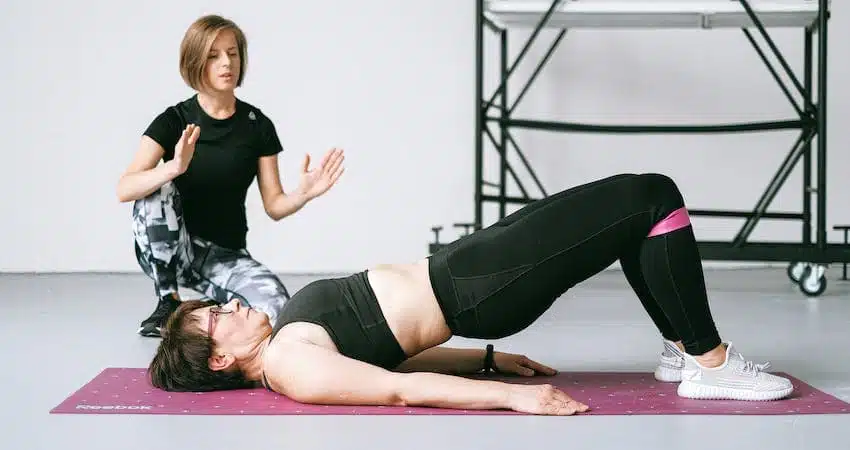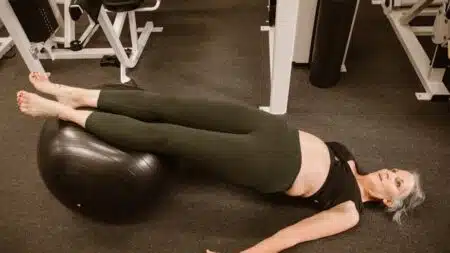When you think of posture, you likely imagine the position of your neck, shoulders, and spine. But posture involves alignment of your entire body—including key muscles below the belt that support pelvic health. The orientation of your pelvis greatly impacts your pelvic floor muscles, a hammock-like layer that supports organs and controls continence. When posture is off, these small but mighty muscles must work harder, often leading to pelvic floor disorders.
Understanding exactly how whole-body posture impacts the critical pelvic floor can help you take control of pelvic health. Take a new look at how you hold your body and simple changes you can make to keep this vital area working properly.
Defining Ideal Posture
Posture refers to the orientation of various body parts in relation to one another while sitting, standing, or moving. Proper posture involves aligning bones and joints stacked vertically so muscles and ligaments are balanced without strain.
Key markers of ideal upright posture include:
- Ears aligned above shoulders, not jutting forward
- Shoulders pulled gently back, not rounded forward
- Chest lifted, not collapsed downward
- Neutral pelvis that avoids tilting too far forward or backward
- Long spine with natural arches maintained
- Engaged core muscles providing stability
- Knees facing straight ahead over ankles, not caving inward
When posture falters, muscles and connective tissues must work harder to resist problematic forces altered alignment creates. Over time, this leads to accumulated microtraumas, pain, and dysfunction.
The Pelvic Floor's Vital yet Challenging Role
The pelvic floor refers to a layer of interlaced muscles spanning the bowl of the pelvis. These muscles attach to the pubic bone in front and the tailbone in back, forming a supportive hammock-like structure.
The pelvic floor serves three main roles:
- Supporting pelvic organs like the bladder, bowel, and uterus
- Assisting in urinary and fecal continence control
- Enhancing sexual performance and pleasure
These muscles work nonstop, even during simple daily movements. As you walk, bend, twist, cough, laugh, or lift something heavy, the pelvic floor rhythmically contracts and relaxes to support organs and maintain continence control.
This challenging job keeps the pelvic floor on near-constant duty. Issues surface when these small muscles must work extra time due to problematic posture misaligning the pelvis.
How Pelvic Orientation Impacts Floor Function
Picture a table with four sturdy, evenly sized legs. It stands balanced and steady on any surface. Now imagine one leg buckling inward. The table teeters to that side, requiring the remaining three legs to dynamically adjust and overcompensate to stabilize the top.
This analogy depicts what happens within your pelvis when posture is compromised. Your pelvic bones act as the “tabletop”, while surrounding ligaments, fascia, and muscles work in tandem as the supportive “legs”.
When standing posture falters, the pelvis can tip forward or backward, rotate or hike up unevenly. This forces connective tissues and muscles like the pelvic floor to strain as they work overtime trying to re-center the pelvis.
Picture the pelvic floor muscles constantly struggling to perform their duties while other postural structures slack or pull the pelvis off-kilter. This pattern overstretches or weakens the pelvic floor over time. Surrounding connective tissues may also grow taut, restricting the pelvic floor’s ability to fully relax and contract.
The end result is often bladder or bowel leakage, bulging organs, pain symptoms, and issues like painful intercourse or straining during bowel movements.
Four Posture Problem Areas That Strain the Pelvic Floor
Now that you understand the vital link between posture and pelvic health, let’s explore four key areas where suboptimal posture misaligns the pelvis and strains the pelvic floor:
- Excessive Lumbar Curvature: An overarched lower back shifts the pelvis posteriorly, overworking back of pelvis structures.
- Anterior Pelvic Tilt: A protruding belly and curved lower back tilt the pelvis anteriorly, straining attachments to the pubic bone.
- Uneven Pelvis: One hip hiking higher puts asymmetrical forces through the pelvic floor.
- Rounded Shoulders: Slumped shoulders shift the ribcage posteriorly onto pelvic organs.
When posture falters in any of these ways, the pelvic floor pays the price through tissue overload, reduced flexibility and weakened contractions over time. But with conscious postural corrections, you can ease the burden on this vital area.
Four Posture Fixes to Relieve Pelvic Floor Strain
Now that you understand exactly why whole-body posture impacts the pelvic floor, explore simple ways you can update alignment for a pain-free pelvis:
- Sit Tall: Perch at your sit bones whenever seated, letting legs hang long without crossing. Draw your lower ribs gently inward as you lift through the top of your chest and head.
- Stand Balanced: Distribute weight evenly as you stand. Engage core muscles gently without overly arching back. Feel each foot grounded while lifting chest.
- Move Frequently: Shift positions often, whether sitting or standing. Brief walking or stretching breaks give the pelvic floor a needed respite.
- Release Tension: Make time for self-myofascial release using massage balls or foam rollers to ease tight spots related to poor posture.
As always, consulting posture and pelvic health experts proves wise to identify personalized problem areas and corrective exercises. But these simple adjustments provide an excellent start relieving postural strain on the pelvic floor.
Warning Signs of Pelvic Floor Dysfunction
See your doctor promptly if you experience any of the following potential signs of overloaded pelvic floor muscles:
- Leaking urine when coughing, sneezing or moving
- Frequent sudden urges to urinate
- Inability to fully empty bladder
- Constipation or straining with bowel movements
- Bulging sensation or organs protruding from vagina
- Heaviness, pressure, or pain within pelvis or perineum
- Painful intercourse
- Lower backache that worsens with standing
Catching pelvic floor dysfunction early allows treatment interventions before symptoms escalate. Your physician can refer you to a pelvic health physical therapist for rehabilitation.
Pelvic Floor Physical Therapy Solutions
If you already have a diagnosed pelvic floor disorder like urinary incontinence, seeking care from a pelvic physical therapist proves vital to restoring proper function. They offer many techniques to relieve pelvic floor muscle and connective tissue restrictions:
- Manual therapy to release shortened muscles and fascia
- Neuromuscular retraining to improve pelvic floor coordination
- Biofeedback to enhance pelvic floor awareness and control
- Electrical stimulation to reduce spasms and pain
- Exercise and stretching for strength, flexibility and stability
- Postural correction and body mechanics education
- Strategies for relieving constipation or bladder spasms
Your custom treatment plan will rebalance the pelvic floor while updating whole-body posture to prevent problems from recurring.
Preserving Pelvic Floor Health Through Ideal Posture
Given the pelvic floor’s nonstop role supporting pelvic organs and controlling continence, keeping these small but crucial muscles healthy is imperative. However, certain postural habits can sabotage pelvic function by straining tissues.
With mindful posture corrections, you can take pressure off the pelvic floor to minimize leaking and discomfort. The following lifestyle habits preventively protect pelvic support:
- Maintaining ideal spinal alignment without excessive arching or rounding
- Engaging core muscles appropriately to stabilize pelvis in neutral
- Distributing weight evenly through feet when standing
- Avoiding positions that anteriorly or posteriorly tilt pelvis
- Moving positions frequently and taking regular movement breaks
- Releasing tense muscles using self-massage techniques
- Practicing proper body mechanics during lifting and daily activities
As you now understand, whole-body posture and pelvic alignment truly impact pelvic health and continence control. Paying more attention to how you hold your body allows the pelvic floor to function properly so you can move through life with ease. Implement the above posture tips during daily tasks, and don’t hesitate to seek professional guidance maximizing support. With small proactive adjustments, you can keep your pelvic region strong and supported for optimal function.



